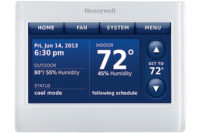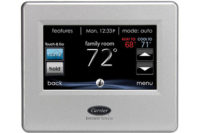
According to Daikin AC (Americas) Inc., its VRV III system is designed to answer larger scale building applications.
New technology keeps commercial contractors on their toes. Sometimes it isn’t just a new unit. Sometimes it’s a new component that revolutionizes the operation of a unit. When new technology comes, understanding its operation and usage is the key to effective implementation of the new designs and features.
As contractors endeavor to implement new and alternative rooftop technologies, questions often arise as to what the best choice is for each customer. What many of them have found, however, is that no one solution can be effective for every customer.
ALTERNATIVE SYSTEM
In examining new alternatives and components of conventional rooftop systems, contractors are discovering things such as the use of UV light systems in commercial applications. They are also discovering geothermal, condensing boilers with variable-speed air handlers, heat recovery ventilators (HRVs), and energy recovery wheels.Lou Bindner, founder of Climate Engineering Inc., Denver, has discovered the use of ductless mini-splits as well. “We have used ductless mini-splits, where they can be applied, in lieu of rooftop units,” he said. “They provide better zone control, are far quieter, and less visually intrusive on roofs.
“The market is also ripe for truly variable-capacity units, i.e., available with compressors and fans with variable-frequency drives.”
One such new rooftop alternative is Daikin AC (Americas) Inc.’s VRV® III. This is the seventh generation of the original Daikin VRV launched in 1982. According to the company, the improvements include a 460-V, three-phase power supply, capacity up to 20 tons, connections up to 41 indoor units from one piping network, and excellent part-load efficiency performance.
“The VRV III system is designed to answer larger scale building applications and compete with traditional central plant technology, solving many issues along the way,” explained Russell Tavolacci, vice president of Daikin AC. “The system offers advanced zoning capability with up to 200 percent diversity, a refrigerant auto-charge function, 540 feet for a single piping run yielding 3,280 feet total in the VRF segment, and Daikin inverter variable-speed compressor technology.”
The unit features flexible piping and a wiring design that, according to Daikin, simplifies the entire installation process. The system wiring is nonshielded and nonpolarized, and the address of each indoor unit is set automatically as it is connected in a daisy chain, eliminating the need to set it manually. The outdoor units can be transported in building elevators without the need for special cranes or lifting equipment, according to Christina Trondsen, director of marketing for Daikin AC.
“Daikin AC is making a commitment to the needs of contractors with the launch of the VRV III,” she said.
ROOFTOP COMPONENTS
Entire alternative systems are not the only new pieces of technology that commercial contractors installing and maintaining rooftop systems can benefit from. The following are some highlights of new component innovations.This year, Lennox introduced the new MSAV™ (multistage air volume) supply fan technology in its Strategos rooftop units. The primary goal of this innovation is to help business consumers reduce energy needs.
According to Lennox, Strategos’ MSAV supply fan technology can provide up to seven levels of airflow, helping control energy usage while meeting comfort requirements.
For example, when there is a low demand for cooling and only one compressor is active, the unit will reduce airflow to save energy. As the cooling demand increases and the unit activates additional compressors, the unit increases airflow to provide more cooling capacity. It can provide up to four different airflow levels for cooling, another for heating, one for ventilation, and another for smoke detector mode. It is preset at the factory for quick startup, but the user has the flexibility to customize airflow settings.
Carrier custom designed its rooftop unit multiprotocol (RTU-MP) controller to be an integrated component of its rooftop units.
According to the company, its preconfigured internal application programming provides optimum performance and energy efficiency by monitoring and controlling the rooftop unit’s heating, cooling, and economizer operations.
The component enables the unit to run in a 100 percent stand-alone control mode, or it can communicate to the customer’s building automation system (BAS). Onboard DIP switches allow the immediate protocol selection of choice from BACnet®, Modbus, Johnson Controls N2, and LonWorks®. The unit also has built-in support for Carrier’s handheld service tool or visibility from the selected building automation protocol.
Trane’s Precedent™ line of 15 SEER packaged rooftop systems features ReliaTel™ technology. Test modes enable the installer to check the unit in all modes of operation (economizer, indoor fan, cooling, and heating modes), reducing the amount of time necessary for the final run test performed by the contractor, said the company.
Its intelligent fallback affords the capability to operate the unit without a thermostat or zone sensor. The unit ships with an outdoor sensor; however, contractors can disconnect this sensor, connect it to the low-voltage terminal block, and place the sensor in the return of the unit, causing it to maintain 74°F cooling, 71° heating, and constant fan until a thermostat or zone sensor can be installed.
ReliaTel also offers a compressor lead-lag system that can be applied on two compressor systems to balance the wear on compressors. Rather than operating one compressor on the first stage all the time, it alternates compressors, providing equal operation and wear between the two compressors - improving the reliability of the system.
PROGRESSING TOGETHER
New technology and features don’t negate the need for cooperation between manufacturers and contractors, according to Bindner.“Dependability, tenant comfort, fair pricing, prompt service, long serviceability, and reduced energy consumption … these are all reasonable expectations,” he said. “If we work as a team of manufacturers, system designers, and contractors, there is no reason these expectations can’t be met.”
Publication date:06/16/2008



